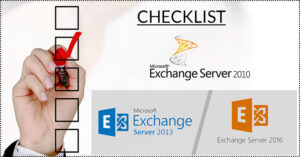Disclaimer:– To export from any version of Exchange to PST file format/ to any other Exchange version/ Office 365, a one-stop solution is provided in this write-up. Shoviv Exchange Recovery Manager is developed as a multi-purpose utility for Exchange Server-related tasks. However, this blog is focused on Exchange 2016 to PST export task, while the Shoviv tool works for all Exchange versions/ EDB files. Explore this professional tool and explore all its dimensions”. Read more...
If you are on the search for a solution to export Exchange 2016 mailbox to PST, your search will end with this write-up. Moreover, this blog will cover all the dimensions to export Exchange 2016 to PST: reasons, methods, and processing. Read the full blog to get a gist of this task, including the advantages and demerits of different execution methods.
Why do users export Exchange 2016 mailboxes to PST?
The answer for why varies from user to user; still, some common reasons initiate this task. A few of them are listed below:
- A backup in the local machine and .pst is best suitable for this.
- To free-up space in the Exchange Server by saving data from the Archive mailbox (mostly) and others in the PST files.
- PST files provide easy accessibility, and also it is very easy to port.
- PST file comes with password protection; another reason for users’ tilt toward the.pst files.
Shoviv Exchange Recovery Manager Tool is available for free download. The tool is very easy to use. Let us know if you have any issues related to the tool and Exchange to PST. Our team is here for you 24*7.
What are the ways to export Exchange 2016 to PST?
Two ways can be opted to export the mailbox to PST Exchange 2016 version for the users. One is opting for a manual mode, and another is using an automated third-party tool. Here, we will discuss both of them in a very straightforward way. Also, the pros and cons will be addressed; the final decision will be yours.
Manual ways to export Exchange 2016 mailbox to PST:
Users have two methodologies to manually export the Exchange mailbox to PST: Exchange Admin Centre and PowerShell Command.
-
Using Exchange Admin Centre
Below, I am mentioning a step-by-step process to export mailbox to PST Exchange 2016 using the Exchange Admin Centre.
- Firstly, make login to Exchange Admin Centre.
- Click on the Recipients, then on the Mailboxes.
- Choose the mailbox to export and right-click on it.
- Then, select Export to a PST file option.
- Provide the path and click on Next.
- After that, check/uncheck according to the need. Moreover, provide the email if you want to get an email after the completion.
-
PowerShell Command
To export mailbox to PST Exchange 2016 PowerShell, open the Exchange Management Shell and run the New-MailboxExportRequest command.
To export User Mailbox to PST:
New-MailboxExportRequest -Mailbox “mailbox name” -FilePath “\\ServerName\FolderName\nameoffile.pst”
To export Archive Mailbox to PST:
New-MailboxExportRequest -Mailbox “mailbox name” -FilePath “\\ServerName01\FolderName\nameoffile.pst” -IsArchive
To export Shared Mailbox to PST:
New-MailboxExportRequest -Mailbox “name of the shared mailbox” -FilePath “\\ServerName02\Folder\nameoffile.pst”
To export Specific Date Range:
New-MailboxExportRequest -ContentFilter {(Received -lt ’03/09/2022′)-and (Received -gt ’03/09/2021′)} -Mailbox User1 -Filepath \\ Exchange\{PST}\{file-name}.pst
Drawbacks and limitations of manual methodologies:
- As you can see, it is a highly complex process, so the doer should be a tech geek. For non-technical users, it is like a walk on eggshells.
- Users do not get any advanced options that may be required. I.e., don’t get a filter, PST size setting open and all.
- There will be variations for running the command with different Exchange versions’ users.
- Running this process in this way seeks too much time.
- Chances of human error and technical glitches are always possible.
A Professional way to Export Exchange 2016 mailbox to PST:
Professionals always search for an automated utility. To export Exchange 2016 mailbox to PST, Shoviv Exchange Recovery Tool is an advanced, featureful, and effortless solution. With this tool, the exportation task is just a matter of a few clicks. Some of its highlighted features are:
- Along with exporting Exchange to PST files, this tool allows saving in MSG, EML, HTML, and RTF-like file formats, similarly to .pst.
- It supports all the versions of the Exchange Server. I.e., Users can also export Exchange 2010 to PST.
- As a source along Exchange Server Mailboxes, users can also add Office 365 mailboxes, EDB files, and Outlook Profile Store.
- This tool is also an expert in recovering inaccessible/corrupt .edb files before the exportation.
- Users can export Exchange 2016 all mailbox to PST in a single go.
- An advanced facility called “Incremental Export” is also provided within this tool. This functionality resumes the process and prevents duplicity in the target.
- Users can also set passwords, type, and size for the resultant PST files.
- The utility also gives search, filter, and preview facilities.
- The GUI of the tool is very user-friendly; hence any non-technical can run it without any hassle.
Wrapping up:
This write-up taught us how to export Exchange 2016 mailbox to PST. Firstly, we discussed manual ways, including Exchange Admin Centre and PowerShell Command; also, we covered the limitations of the manual methods. Finally, we knew a professional solution: Shoviv Exchange Recovery Manager. In conclusion, this utility developed by Shoviv offers a proficient and effortless way that boosts users’ working experience. Users can check the tool’s functioning before purchasing the free trial version.
- How to Backup and Restore Emails in Webmail? - March 25, 2025
- How to Migrate Outlook to New Computer? - February 15, 2025
- Fix If Outlook Cannot Display the Specific Folder Location - February 1, 2025



